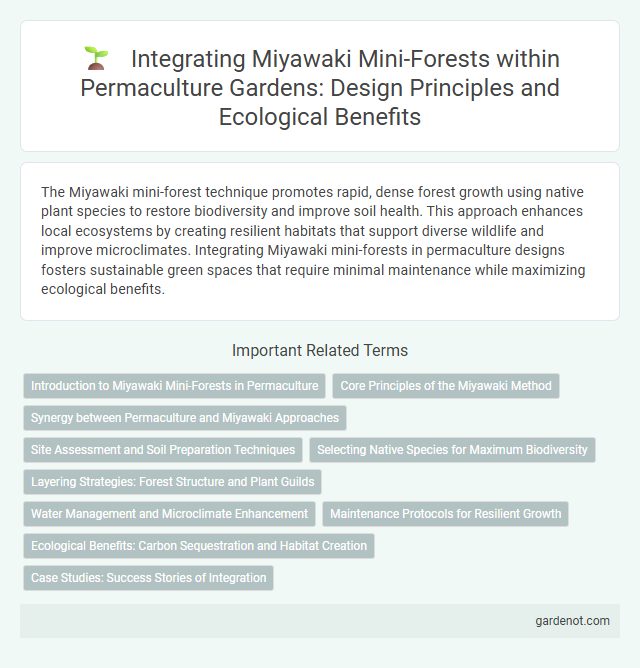The Miyawaki mini-forest technique promotes rapid, dense forest growth using native plant species to restore biodiversity and improve soil health. This approach enhances local ecosystems by creating resilient habitats that support diverse wildlife and improve microclimates. Integrating Miyawaki mini-forests in permaculture designs fosters sustainable green spaces that require minimal maintenance while maximizing ecological benefits.
Introduction to Miyawaki Mini-Forests in Permaculture
Miyawaki mini-forests are dense, native tree plantations designed to restore biodiversity and enhance ecosystem services within small urban or degraded spaces. This technique leverages native species for rapid growth, creating self-sustaining forests that improve soil health, increase carbon sequestration, and support wildlife habitats. Implemented within permaculture, Miyawaki mini-forests contribute to sustainable land use by integrating natural forest regeneration principles into urban ecological design.
Core Principles of the Miyawaki Method
The Miyawaki method emphasizes native species planting, soil improvement with organic matter, and dense planting to foster rapid growth and biodiversity. It relies on minimal maintenance, natural succession, and creating multi-layered forest structures to replicate natural ecosystems in a short time. This approach enhances soil health, increases carbon sequestration, and supports resilient urban microclimates through optimized native plant communities.
Synergy between Permaculture and Miyawaki Approaches
The Miyawaki mini-forest method complements permaculture by accelerating dense, native forest growth through layering diverse species that mimic natural ecosystems. This synergy enhances soil health, biodiversity, and microclimate regulation, aligning with permaculture's principles of sustainability and resource optimization. Integrating Miyawaki techniques into permaculture design amplifies ecosystem resilience and productivity in small urban or degraded spaces.
Site Assessment and Soil Preparation Techniques
Site assessment for Miyawaki mini-forests involves analyzing soil pH, texture, moisture levels, and sunlight exposure to ensure optimal growth conditions for native species. Soil preparation techniques include aeration, addition of organic compost, and removal of weeds to enhance microbial activity and nutrient availability. Emphasizing native soil microbiota supports rapid vegetation growth and ecosystem restoration in compact urban spaces.
Selecting Native Species for Maximum Biodiversity
Selecting native species for Miyawaki mini-forests ensures robust biodiversity by promoting local ecological balance and supporting indigenous wildlife. These native plants adapt naturally to the regional climate, soil, and pests, accelerating forest growth and resilience. Emphasizing diverse native species enhances soil health, water retention, and habitat complexity, creating a sustainable micro-ecosystem.
Layering Strategies: Forest Structure and Plant Guilds
Miyawaki mini-forests utilize intricate layering strategies inspired by natural forest structures, incorporating multiple vegetation strata including emergent trees, canopy, understory, shrub, herbaceous, and ground cover layers to maximize biodiversity and ecosystem services. Plant guilds are carefully selected to promote symbiotic relationships among species, enhancing nutrient cycling, pest resistance, and soil health. This forest structure accelerates growth, improves carbon sequestration, and creates resilient, self-sustaining ecosystems within compact urban or degraded landscapes.
Water Management and Microclimate Enhancement
Miyawaki mini-forests employ dense planting techniques that significantly improve water retention by enhancing soil permeability and reducing surface runoff. This method supports efficient rainwater harvesting, allowing micro-ecosystems to flourish even in urban environments. The resulting microclimate stabilization lowers ambient temperatures and increases humidity, creating a resilient habitat that mitigates heat island effects and supports biodiversity.
Maintenance Protocols for Resilient Growth
Miyawaki mini-forests require systematic maintenance protocols including regular watering during the initial 2-3 years to ensure seedling establishment and soil moisture retention. Pruning and weeding are critical to eliminate invasive species and enhance light penetration, promoting diverse understory growth. Soil health monitoring combined with mulching supports microbial activity and nutrient cycling, fostering resilient forest ecosystems.
Ecological Benefits: Carbon Sequestration and Habitat Creation
Miyawaki mini-forests significantly enhance carbon sequestration by rapidly absorbing CO2 through dense, native vegetation, contributing to climate change mitigation. These forests create vital habitats for diverse flora and fauna, boosting local biodiversity and restoring ecological balance in urban and degraded areas. By mimicking natural forest ecosystems, Miyawaki plantations improve soil health, water retention, and microclimate regulation, promoting sustainable environmental resilience.
Case Studies: Success Stories of Integration
Miyawaki mini-forests have transformed urban spaces worldwide, with case studies from cities like Tokyo, Delhi, and Sao Paulo demonstrating rapid tree growth and enhanced biodiversity within just a few years. In Delhi, a Miyawaki forest established in 2020 increased local bird species by 45%, while Tokyo's project reduced ambient temperatures by up to 2degC. These success stories highlight the technique's effectiveness in regenerating ecosystems, improving air quality, and fostering community engagement in reforestation efforts.
Miyawaki mini-forest Infographic

 gardenot.com
gardenot.com